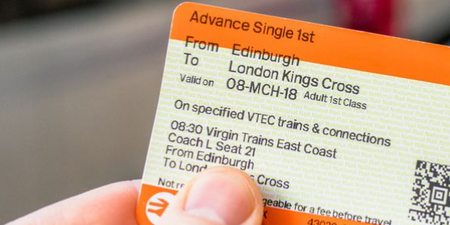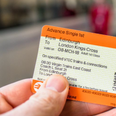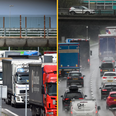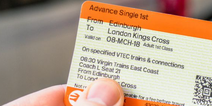Only one in five trains are expected to be running each day
First it was planes, now its trains.
After weeks of cancellations and delays at airports across the UK, now rail commuters are being hit, with the biggest rail strike in three decades taking effect Monday and lasting most of the week. Getting to work, exams and even Glastonbury isn’t going to be easy.
Here’s everything you need to know.
What strikes are happening when?
Walkouts on major lines are officially planned on Tuesday, Thursday and Saturday, but services will be impacted from later on Monday. Even on non-strike days, Brits have been warned to expect disruption as a result of fewer staff working across the network.
Londoners looking to catch the Tube will also face difficulties, with a strike planned across the London Underground network on Tuesday, but services are expected to be impacted across the week, Transport for London (Tfl) has warned.
The map below gives an idea of how Network Rail services will be affected.
For more information, a special timetable from June 20 to 26 has been published.
Disrupted lines include: Avanti West Coast, C2C, Chiltern Railways, Cross Country Trains, Croydon Tramline, Greater Anglia, LNER, East Midlands Railway, Elizabeth Line, Great Western Railway, Hull Trains, London Underground, Northern Trains, South Eastern Railway, South Western Railway, TransPennine Express, West Midlands Trains.
Another rail union, Aslef, has its own action taking place, with drivers striking on Greater Anglia this Thursday and on July 2, as well as on the Croydon Tramline on June 28 and 29, and July 13 and 14. Ballots are currently being held on striking on other lines.
And why are drivers striking?
The Rail, Maritime and Transport Workers Union (RMT), which represents all kinds of railway staff, said its members have been subject to “pay freezes, threats to jobs and attacks on their terms and conditions”. They are asking for 7 per cent pay rises, but the government’s offer is reportedly in the region of 2 to 3 per cent.
A potential move to driverless trains and the possible closure of many ticket offices is also causing tension surrounding redundancies.
Just another gentle reminder that #ToryRailStrikes are not about Train Drivers, or their salaries, but about @RMTunion members fighting to defend their jobs, pay and conditions pic.twitter.com/m9VNqW9r5h
— RMT (@RMTunion) June 20, 2022
The median salary for rail travel assistants, such as ticket collectors and guards, is £33,310 and £59,189 for train drivers, latest figures from the Office for National Statistics show.
But the union says the strikes are not in fact about salaries, but about “members fighting to defend their jobs, pay and conditions”.
How big is the strike?
This is the biggest rail strike the nation has seen in 30 years. The RMT Union said 40,000 Network Rail staff and 13 train operators will take action on official strike days. Some train routes will start as late as 10am and finish at 2pm, and not all stations will be served.
Only one in five trains are expected to be running.
Who will be impacted?
Commuters will be most acutely affected by the strikes, with millions scrambling to make the last train home on Monday evening.
The 200,000-odd festival-goers heading to Glastonbury will also be hit hard, with over half the train services due to go to the festival being axed.
Students could also miss GCSE and A-Level exams as a result of strike action. Student Beans‘ head of youth insights, Jessica Pinkett, warned this could leave some young people at an “unfair advantage”.
As a result of train chaos, motorists are being warned to expect a huge surge in traffic this week. The AA thinks the worst-affected roads will be the main motorways, in addition to rural and suburban areas.
The situation could be life or death for some people.
An unnamed health boss told the Health Service Journal (HSJ) that “rail strikes will probably end up killing people because they’ll prevent ambulance trust staff getting to work”.
London Ambulance Service has also diverted more staff to the frontline and will ask some patients to make their own way to hospital as a result of the rail strike, as well as significant demand and hot weather.
Can the dispute be solved?
Two sets of talk are expected Monday, but these are unlikely to be successful. Ministers are resisting giving rail workers the pay rise they want, as they argue it will drive up fuel inflation and allow other sectors to demand more money.
And, more worryingly yet, this might only be the start of strike action with Mick Lynch, general secretary of the RMT union, telling the i Paper that Brits should expect a “long fight” with disruption continuing well into Autumn.
Teachers and doctors are also threatening to walk out if the government fails to meet rail workers’ pay demands, The Times reports.
What has the reaction been?
The rail strike was splashed across the front pages of most national papers on Monday morning. “Network derailed” is the headline Metro went with, warning that commuters will face “days of misery” because of the action.
Though if you actually look at what Brits are saying, it seems a lot of us are pretty pleased with the opportunity to work from home for the whole first week of summer.
Train strikes so I get to work from home this week 😊 #RailStrikes
— EFHus (@hus_ef) June 20, 2022
Some have already taken to Twitter to share pictures of them enjoying breakfast and beverages in the sun.
“Thanks to you brave lads I get to WFH in the sun,” one Tweeted.
“Keep up the good non-work union chaps,” another added.
How can I get around it?
There’s no beating around the bush – travelling this week is going to be tough. But there are some limited ways around it.
About 4,500 services will still run, according to Network Rail, though that is compared to the 20,000 that normally do. The trains that do run will start later and finish between 7.30am and 6.30pm.
If it’s any consolation, customers have been promised a refund if their train gets cancelled, delayed or rescheduled. And if you have a ticket for one of the strike days, you can use it the day before, or until Tuesday of the following week. Season ticket-holders can claim compensation for strike days if they choose not to travel. Passengers are advised to ask operators about switching to other routes to avoid disruption.
Some travel bosses are suggesting Brits avoid train travel for the whole week, while TfL is urging those in the capital to walk or cycle to work as opposed to getting the Tube. Those who do choose to get the Tube are cautioned not to do so before mid-morning. An enhanced bus service will run but is expected to be very busy.
If you are in London and fancy the walk, there is a map which shows you how much time it takes to walk between stations on the same line in zones 1 to 3.
Tube-users should aim to compete their journeys by 6pm, TfL said, or by 4pm if travelling between Paddington and Reading or Shenfield and Liverpool Street on the Elizabeth line. TfL has published advice on limited services that are running on the Underground and Overground.
Related stories:
RELATED ARTICLES






MORE FROM JOE
























MORE FROM JOE


























